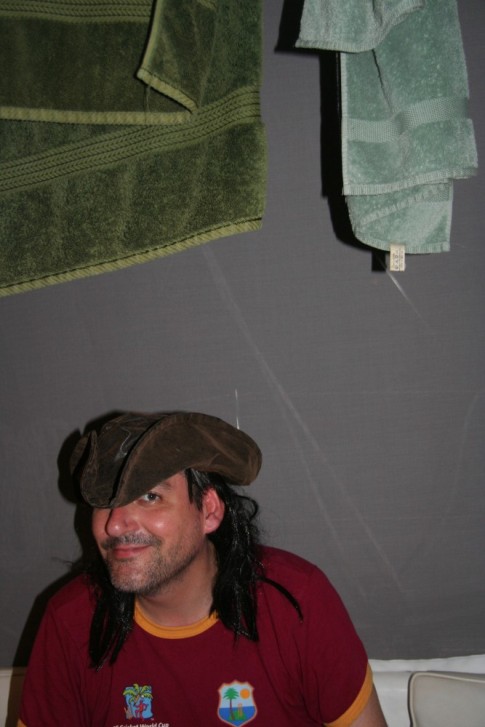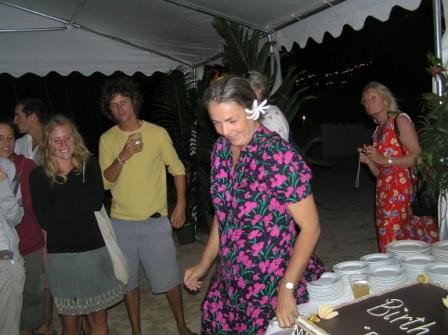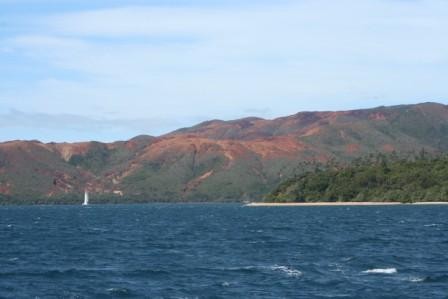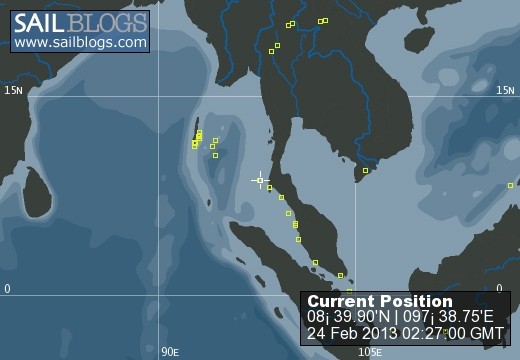
Around the World
23 February 2013 | Similan Islands Thailand
21 February 2013 | Bay of Bengal
15 February 2013 | Cinque Islands
15 February 2013 | Henry Lawrence Island
12 February 2013 | North Button Island
10 February 2013 | Henry Lawrence Island
09 February 2013 | Havelock Island
06 February 2013 | Neil Island
04 February 2013 | Rutland Island
01 February 2013 | Andaman Sea
30 January 2013 | Port Blair
26 January 2013 | Andaman Sea
26 January 2013 | Andaman Sea
03 December 2012 | Burma
02 December 2012
08 November 2012
08 November 2012 | Thailand
08 November 2012
10 June 2012 | Rebak Marina Langkawi
06 February 2012 | Malaysia
fresh air and chinese villages
25 January 2010 | Dali
Michael and Jackie
We headed next for Dali in the foothills of the Himalayas. I don't know if the painter was inspired by the town but it is possible. We arrived at a brand new airport, the Boeing 737 linked up to an airway - the only plane there. We walked out through the terminus to the taxi rank. No-one accosted us , absolutely no hawkers, basically apart from the alighting passengers, empty. The taxi takes you along the side of the lake past the new city, and skirts the old city. Our destination was about an hour north of old Dali. The last 40 minutes of the journey is on a two way road of which more later.
We had booked in at a placed called the Linden Centre. The small hotel is a conversion of a Bai house. It is built around courtyards. The preferred accommodation for Bai people is on the West side with a painted wall to catch the early sun on the opposite side. The building is owned by a Chinese American couple and is filled with antiques and artefacts. A remarkable place. The house is situated in a peasant village called Zixhou.
We borrowed some bikes and set off down the narrow flat lanes dividing the fields, heading first for the lake. We found a small peninsula park and looked across. The flat fields fall away into the vast misty waters of the lake, and the distant mountains beyond. Children played on the bikes and tried out their English on us. Unfortunately their English wasn't much better than our Mandarin. We cycled back, past the fishermen and women, the odd cow being taken for a walk, and into a different village. Within the villages people use horse drawn carriages with two rows of seating and a colourful awning for sun protection. We stopped in the centre and one of the drivers pointed us on our way. Narrow streets and simple buildings are the norm. There are few cars, quite a few bicycles, but this is a China which has not changed for centuries, except possibly mobile phones and electricity. In the fields everything is done by hand, lines of women plant out seedlings, others hoe for weeds or dig by hand the small plots. Along the roads trucks powered with belt drives from a two stroke engine are the only form of automation you will see. We cycled on getting increasingly sore from the uncomfortable saddles, we had no way of adjusting them, and increasingly lost. We eventually found our way back crossing another village, various field roads, climbing over a dyke and onto the road back to our hotel. The dyke was one around a whole series of quite large ponds which seemed to have been used for fish farming at some stage. We returned to a traditional meal and some quite palatable Chinese wine.
The next day we explored the town of Dali which has much Tibetan infuence and many Buddhist monasteries up in the hills overlooking the town. Dali was the capital of the ancient kingdom of the Bai people. We asked Frank, our host about the ethnic proportions. He explained that the town was 60% Bai and said there were a few Han amongst other ethnic minorities. An interesting reversion of the way in which the majority Han population of China speak of their minorities. In the 1860s Dali was the centre of a Muslim rebellion which led to the creation of a Muslim state. Millions were killed and Dali's Muslim population is now relatively small, compared with the majority Bai people. In Dali you see a real cosmopolitan mix of people wearing Bai costume, shawled Muslim women, people with obviously Tibetan looks, and tourists from all parts of China. There is also a strong European contingent, probably ex-backpackers attracted by the relaxed life style. We met artists, bakers, cafe owners. mostly to be found in and around the bars and cafes of "Foreigners Street". Foreigners street is also the favourite street for Chinese tourists.
There are numerous small shops typically selling jewellery, clothes or food. When business is slow you can see the owners of the shops sitting outside with blowtorches and hammers making more silverware. The clothes are brightly coloured and often tie-dyed. There is also lots of beautiful embroidery. Everything is very cheap, but unfortunatley we have no space in our luggage for anything else. The food shops are the most intriguing, all sorts of meats are hanging in the doorways, strange fungi, some of which are medicinal, and beautiful vegetables adorn the shopfronts.
It becomes obvious that China, and especially the Himalayas, are where Camellias originated. The streets are lined with large standard camellias in pots. Everywhere there are pots of Camellias for sale and you see people buying bunches of cut camellias, which here in their home territory seem to have many more flowers. Perhaps because most of the time it is very sunny here. The town is about to have its annual flower festival, unfortunately just after we leave. Stalls were just being set up. Streams run down the centre of many of the streets through landscaped waterfalls and sculptures. Further out the streams turn the occasional waterwheel. However, until our arrival there had been no rain for 7 months we were told. We brought the rain so our last day was marked with a second tour of the town rather than hiking in the mountains. Still the town water features looked good.
At each compass point there are large archway entrances to the town. These have at the top Buddhas under pagoda style arches where people can pay their respect, and on the Northern side there are tall pagodas shaped more as towers in the Tibetan style.
All in all a lovely town which although catering for tourists has not lost its charm.
We had booked in at a placed called the Linden Centre. The small hotel is a conversion of a Bai house. It is built around courtyards. The preferred accommodation for Bai people is on the West side with a painted wall to catch the early sun on the opposite side. The building is owned by a Chinese American couple and is filled with antiques and artefacts. A remarkable place. The house is situated in a peasant village called Zixhou.
We borrowed some bikes and set off down the narrow flat lanes dividing the fields, heading first for the lake. We found a small peninsula park and looked across. The flat fields fall away into the vast misty waters of the lake, and the distant mountains beyond. Children played on the bikes and tried out their English on us. Unfortunately their English wasn't much better than our Mandarin. We cycled back, past the fishermen and women, the odd cow being taken for a walk, and into a different village. Within the villages people use horse drawn carriages with two rows of seating and a colourful awning for sun protection. We stopped in the centre and one of the drivers pointed us on our way. Narrow streets and simple buildings are the norm. There are few cars, quite a few bicycles, but this is a China which has not changed for centuries, except possibly mobile phones and electricity. In the fields everything is done by hand, lines of women plant out seedlings, others hoe for weeds or dig by hand the small plots. Along the roads trucks powered with belt drives from a two stroke engine are the only form of automation you will see. We cycled on getting increasingly sore from the uncomfortable saddles, we had no way of adjusting them, and increasingly lost. We eventually found our way back crossing another village, various field roads, climbing over a dyke and onto the road back to our hotel. The dyke was one around a whole series of quite large ponds which seemed to have been used for fish farming at some stage. We returned to a traditional meal and some quite palatable Chinese wine.
The next day we explored the town of Dali which has much Tibetan infuence and many Buddhist monasteries up in the hills overlooking the town. Dali was the capital of the ancient kingdom of the Bai people. We asked Frank, our host about the ethnic proportions. He explained that the town was 60% Bai and said there were a few Han amongst other ethnic minorities. An interesting reversion of the way in which the majority Han population of China speak of their minorities. In the 1860s Dali was the centre of a Muslim rebellion which led to the creation of a Muslim state. Millions were killed and Dali's Muslim population is now relatively small, compared with the majority Bai people. In Dali you see a real cosmopolitan mix of people wearing Bai costume, shawled Muslim women, people with obviously Tibetan looks, and tourists from all parts of China. There is also a strong European contingent, probably ex-backpackers attracted by the relaxed life style. We met artists, bakers, cafe owners. mostly to be found in and around the bars and cafes of "Foreigners Street". Foreigners street is also the favourite street for Chinese tourists.
There are numerous small shops typically selling jewellery, clothes or food. When business is slow you can see the owners of the shops sitting outside with blowtorches and hammers making more silverware. The clothes are brightly coloured and often tie-dyed. There is also lots of beautiful embroidery. Everything is very cheap, but unfortunatley we have no space in our luggage for anything else. The food shops are the most intriguing, all sorts of meats are hanging in the doorways, strange fungi, some of which are medicinal, and beautiful vegetables adorn the shopfronts.
It becomes obvious that China, and especially the Himalayas, are where Camellias originated. The streets are lined with large standard camellias in pots. Everywhere there are pots of Camellias for sale and you see people buying bunches of cut camellias, which here in their home territory seem to have many more flowers. Perhaps because most of the time it is very sunny here. The town is about to have its annual flower festival, unfortunately just after we leave. Stalls were just being set up. Streams run down the centre of many of the streets through landscaped waterfalls and sculptures. Further out the streams turn the occasional waterwheel. However, until our arrival there had been no rain for 7 months we were told. We brought the rain so our last day was marked with a second tour of the town rather than hiking in the mountains. Still the town water features looked good.
At each compass point there are large archway entrances to the town. These have at the top Buddhas under pagoda style arches where people can pay their respect, and on the Northern side there are tall pagodas shaped more as towers in the Tibetan style.
All in all a lovely town which although catering for tourists has not lost its charm.
Comments
| Vessel Name: | Lady Kay |
| Vessel Make/Model: | Lagoon 380 |
| Hailing Port: | Falmouth |
| Crew: | Michael & Jackie Chapman |
Blue Waters
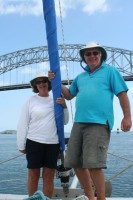
Who: Michael & Jackie Chapman
Port: Falmouth

